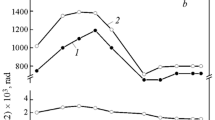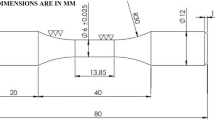Conclusions
-
1.
The susceptibility of aluminum alloys to delayed fracture is connected with the nonuniform decomposition of the solid solution and its low stability. The service life of a part is the shorter the higher the anisotropy of grain boundary fracture, the higher the level of residual stresses, and the lower the threshold stress in the tests for corrosion cracking.
-
2.
The susceptibility of aluminum alloys to corrosion cracking can be eliminated or considerably reduced by using controlled cooling in quenching in combination with artificial aging.
Similar content being viewed by others
References
N. G. Kudryashov and V. I. Smolentsev,Fracture Toughness of Aluminum Alloys [in Russian], Metallurgizdat, Moscow (1976).
J. R. Rice and M. A. Jonson.The Role of Large Crack Tip Geometry Changes in Plane Strain Fracture, Inelastic Behavior of Solids, Kanninen Ed. (1970).
D. Broek,Elementary Engineering Fracture Mechanics, Noordhoff, Leyden (1974).
Fractography and an Atlas of Fractograms, A Reference Book [in Russian], Metallurgizdat, Moscow (1982).
O. N. Mikhailov (ed.),Residual Stresses in Preforms and Parts of Large Machines [in Russian], Uralmashzavod, Sverdlovsk (1971).
G. L. Shneider, “Some special features of fracture in large semiproducts from aluminum alloys,”Metalloved. Term. Obrab. Met., No. 3, 2–7 (1997).
I. N. Fridlyander, K. Shperlink, V. Otchenashek, and L. N. Leshchiner, “Properties and propagation behavior of a crack in pressed shapes from Al−Cu−Li alloys,”Metalloved. Term. Obrab. Met., No. 11, 36–38 (1993).
G. L. Shneider and A. M. Drits, “Hardenability of aluminum-lithium alloys,”Metalloved. Term. Obrab. Met., No. 9, 26–30 (1995).
G. L. Shneider, L. M. Sheveleva, Yu. V. Shchelbanin, and Yu. P. Plotnikov, “Controlled cooling of stampings from alloy 1420,”Tekhnol. Legk. Splavov, No. 4, 29–30 (1992).
G. L. Shneider, L. M. Sheveleva, N. A. Parkhomenko, and A. D. Petrov, “Dependence of service characteristics of deformed semiproducts from alloy 1420 on the parameters and components of morphology and structure,”Tsvet. Met., No. 11, 52–54 (1993).
E. Kodzima, “Aluminum-lithium alloys,”Keykindzoku,39(1), 67–80 (1989).
G. L. Shneider, L. M. Sheveleva, and E. Ya. Kaputkin, “Phase transformations in heat treatment of alloy 1420,”Tsvet. Met., No. 2, 49–52 (1994).
A. I. Nikolaichik and V. N. Bespal'ko, “Residual stresses in stampings from aluminum alloys and parts produced from them,”Tekhnol. Legk. Splavov, No. 7, 24–27 (1981).
G. L. Shncider, A. G. Vovnyanko, E. A. Dardin, and V. V. Merzlyuk, “Residual stresses in semiproducts and parts from aluminum alloys,”Tekhnol. Legk Splavov, No. 10, 9 (1983).
G. L. Shneider, “Phase transformations in heat treatment of aluminum-lithium alloys and optimization of service properties of semiproducts produced from them,”Metalloved. Term. Obrab. Met., No. 1, 24–30 (1998).
G. L. Shneider, “Stability of supersaturated solid solution of aluminum-lithium alloy 1470,”Metalloved. Term. Obrab. Met., No. 7, 31–35 (1998).
G. L. Shneider, A. M. Drits, N. A. Parkhomenko, and T. V. Krymova, “Stability of superstautrated solid solution of alloy 1450,”Metalloved. Term. Obrab. Met., No. 6, 6–8 (1993).
G. L. Shneider, S. F. Danilov, and E. N. Malysheva “Stability of supersaturated solid solution of alloy 1421,”Tsvet. Met., No. 3, 52–54 (1993).
A. G. Vovnyanko, A. P. Kovtun, Z. N. Kolganova, and G. L. Shneider, “Regular features in the variation of properties in forgings and stampings from aluminum alloys,”Tekhnol Legk. Splavov, Nos. 11–12, 24–31 (1982).
G. L. Shneider, “Dependencies of the characteristics of static and cyclic crack resistance of large forged semiproducts from aluminum alloys 1993 and V95 on the cooling rate in quenching,”Metalloved. Term. Obrab. Met., No. 6, 24–28 (1995).
H. Liebowitz,Fracture, Metals Fracture, in 6 Volumes, Vol. 6, Academic Press, New York, (1971).
H. Liebowitz,Fracture, Engineering Fundamentals and Environmental Effects, in 6 Volumes, Vol. 3, Academic Press, New York (1971).
Patent RF No. 1762573, C22G 1/047, “A method for heat treatment of alloys in the aluminum-magnesium-lithium system,”Otkr. Izobr. (1990).
Patent RF, No. 20485911, C22F 1/047, “A method for heat treatment of semiproducts from deformable aluminum-lithium alloys,”Otkr. Izobr., No. 32 (1994).
V. V. Kafel'nikov, “Relation between the coefficient of stress intensityK lsscc and the threshold stress σcr in corrosion cracking of materials,” in:Proc. Int. Congr. “Protection-95” [in Russian], Moscow (1995), p. 111.
OST 1 90352-95, Aluminum and magnesium alloys. Method for determining the threshold coefficient of stress intensity in corrosion cracking K lscc [in Russian].
Author information
Authors and Affiliations
Additional information
Translated from Metallovedenie i Termicheskaya Obrabotka Metallov, No. 3, pp 18–25, March, 1999.
As a matter for discussion.
Rights and permissions
About this article
Cite this article
Shneider, G.L., Sheveleva, L.M. & Kafel'nikov, V.V. Delayed fracture of aluminum alloys. Met Sci Heat Treat 41, 109–116 (1999). https://doi.org/10.1007/BF02467695
Issue Date:
DOI: https://doi.org/10.1007/BF02467695




